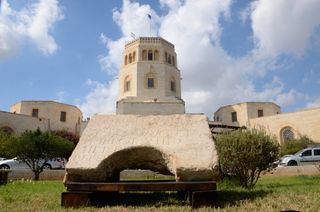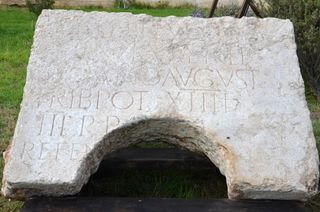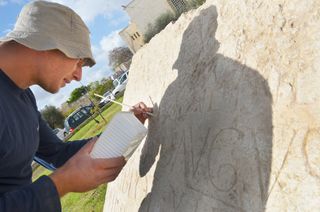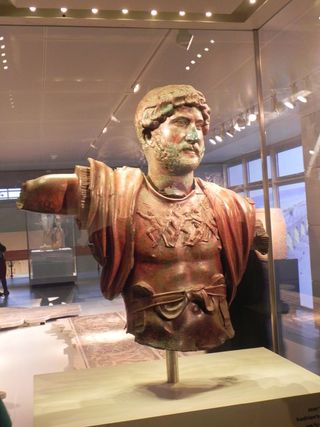In Photos: Engraving Honoring Emperor Hadrian Found In Jerusalem
A piece of limestone commemorating the Roman emperor Hadrian has been discovered in Jerusalem. It's possible that the engraving will offer clues about life in Jerusalem at the time of its carving in 129-130. It may also help historians understand the events that led to the Jewish Bar Kokhba revolt against the Romans from 132 to 136. [Read full story on the new inscription discovery]
Limestone slab

Although this large limestone lab has a pristine engraving about the Roman Emperor Hadrian, it wasn't found in an expected place. People repurposed the slab and used it to create a cistern, a basin that holds water, in ancient times. (Photo credit: Yoli Shwartz, courtesy of the Israel Antiquities Authority.)
Latin letters

The nearly 2,000-year-old inscription was engraved by the Legio X Fretensis, a division of the Roman army, in honor of its emperor, Hadrian, who ruled from 117 to 138. It's rare to find Latin engravings in Israel, especially ones that are easy to read and mention names and dates. (Photo credit: Yoli Shwartz, courtesy of the Israel Antiquities Authority.)
Emperor Hadrian

A bust of the Roman Emperor Hadrian housed in the Musei Capitolini in Rome. Many people, including philosopher Niccolò Machiavelli, viewed Hadrian as an enlightened ruler who, but he also persecuted the Jews in Israel, forcing them to convert. (Photo credit: Marie-Lan Nguyen | Wikipedia Commons.)
Sign up for the Live Science daily newsletter now
Get the world’s most fascinating discoveries delivered straight to your inbox.
Missing piece

The other piece of the inscription was found in the 19th century by French archaeologist Charles Clermont-Ganneau. The public can see the first piece at the Studium Biblicum Franciscanum Museum in Jerusalem. Researchers plan to put the newly discovered piece on display once they publish their research. (Photo Credit: Garo Nalbandian, Courtesy of the Studium Biblicum Franciscanum Museum.)
Preserving history

A researcher preserves the newly found limestone slab at its new location outside the Rockefeller Museum in Israel. (Photo credit: Yoli Shwartz, courtesy of the Israel Antiquities Authority.)
Bar Kokhba revolt

A bronze statue of Hadrian, now stationed at the Israel Museum in Jerusalem, was found in Israel at an ancient camp once occupied by the armed forces of the Sixth Roman Legion. Hadrian's oppressive dictates, called the Hadrianic Decrees, led to the Bar-Kokhba revolt in 132. (Photo credit: Yoav Dothan | Wikimedia Commons.)
Follow Laura Geggel on Twitter @LauraGeggel and Google+. Follow Live Science @livescience, Facebook & Google+. Original article on Live Science.

Laura is the archaeology and Life's Little Mysteries editor at Live Science. She also reports on general science, including paleontology. Her work has appeared in The New York Times, Scholastic, Popular Science and Spectrum, a site on autism research. She has won multiple awards from the Society of Professional Journalists and the Washington Newspaper Publishers Association for her reporting at a weekly newspaper near Seattle. Laura holds a bachelor's degree in English literature and psychology from Washington University in St. Louis and a master's degree in science writing from NYU.











